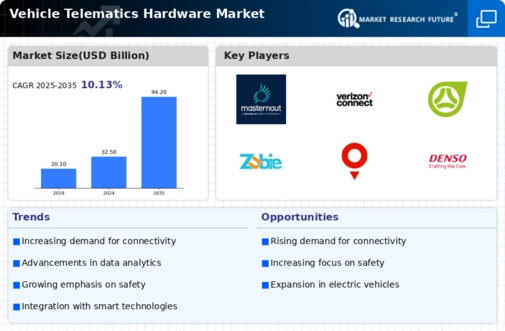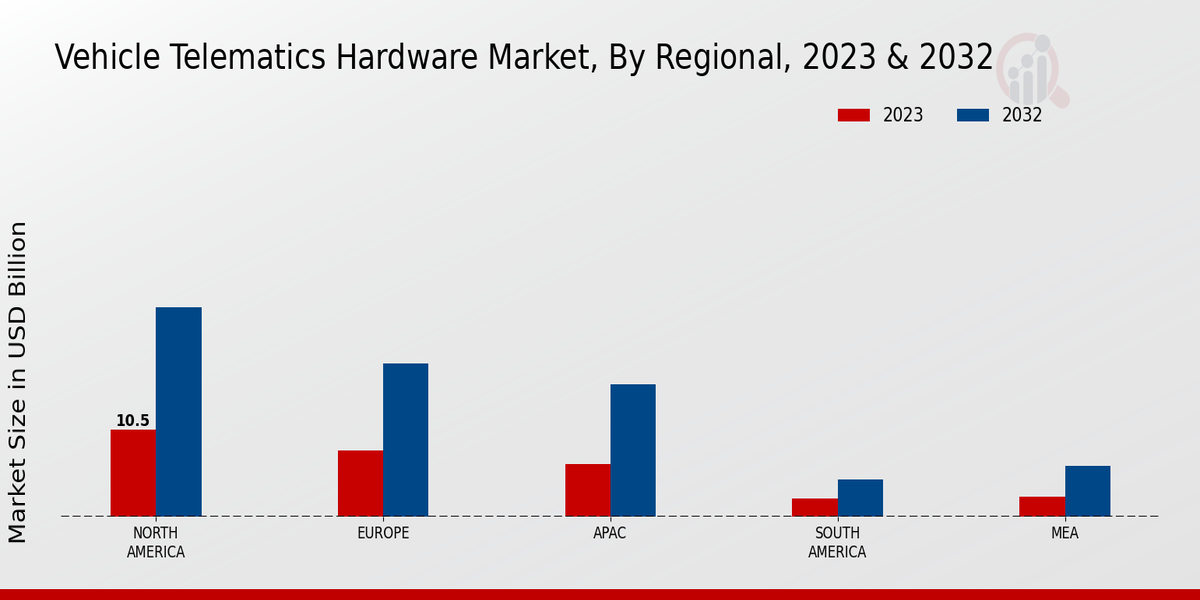Sustainability Initiatives
Sustainability initiatives are becoming increasingly influential in the Vehicle Telematics Hardware Market, as companies seek to reduce their carbon footprint and enhance fuel efficiency. The adoption of telematics solutions allows fleet operators to monitor fuel consumption and optimize routes, leading to lower emissions and operational costs. As environmental regulations tighten, the demand for telematics hardware that supports sustainability goals is expected to rise. Data suggests that fleets utilizing telematics can achieve up to a 15% reduction in fuel consumption, which not only contributes to environmental sustainability but also improves the bottom line. This trend indicates a growing recognition of the role that telematics hardware plays in promoting eco-friendly practices.
Focus on Safety and Compliance
Safety and compliance remain paramount in the Vehicle Telematics Hardware Market, as regulatory bodies impose stricter guidelines on vehicle operations. The increasing emphasis on driver safety and the need to comply with regulations such as the Electronic Logging Device (ELD) mandate have propelled the adoption of telematics solutions. These systems provide critical data that helps organizations monitor driver behavior, ensuring adherence to safety protocols. Furthermore, the integration of telematics hardware can lead to a reduction in accident rates, which is a significant concern for fleet operators. Recent statistics indicate that fleets utilizing telematics solutions have reported a 20% decrease in accidents, underscoring the importance of safety in the telematics hardware market.
Integration of Advanced Technologies
The Vehicle Telematics Hardware Market is experiencing a notable shift due to the integration of advanced technologies such as artificial intelligence, machine learning, and the Internet of Things (IoT). These technologies enhance data collection and analysis, enabling real-time monitoring of vehicle performance and driver behavior. As a result, companies are increasingly investing in telematics solutions that provide actionable insights, which can lead to improved operational efficiency and reduced costs. According to recent data, the market for telematics hardware is projected to grow at a compound annual growth rate (CAGR) of approximately 15% over the next five years. This growth is driven by the demand for enhanced connectivity and the need for fleet management solutions that leverage these advanced technologies.
Increased Connectivity and Data Analytics
Increased connectivity and data analytics capabilities are transforming the Vehicle Telematics Hardware Market, as businesses seek to leverage data for strategic decision-making. The proliferation of 5G technology is enhancing the ability of telematics systems to transmit data in real-time, allowing for more accurate monitoring and analysis of vehicle performance. This connectivity enables companies to harness big data analytics, leading to improved insights into operational efficiency and customer behavior. The market for telematics hardware is expected to benefit from this trend, with projections indicating a potential increase in market size by 20% over the next few years. This shift towards data-driven decision-making highlights the critical role of telematics hardware in modern fleet operations.
Rising Demand for Fleet Management Solutions
The Vehicle Telematics Hardware Market is witnessing a surge in demand for fleet management solutions, driven by the need for enhanced operational efficiency and cost reduction. Companies are increasingly recognizing the value of telematics in managing their fleets, as these solutions provide real-time data on vehicle location, performance, and maintenance needs. The market for fleet management telematics is projected to expand significantly, with estimates suggesting a growth rate of around 12% annually. This growth is attributed to the increasing complexity of fleet operations and the necessity for businesses to optimize their resources. As a result, telematics hardware is becoming an essential component for companies aiming to streamline their fleet management processes.


















Leave a Comment